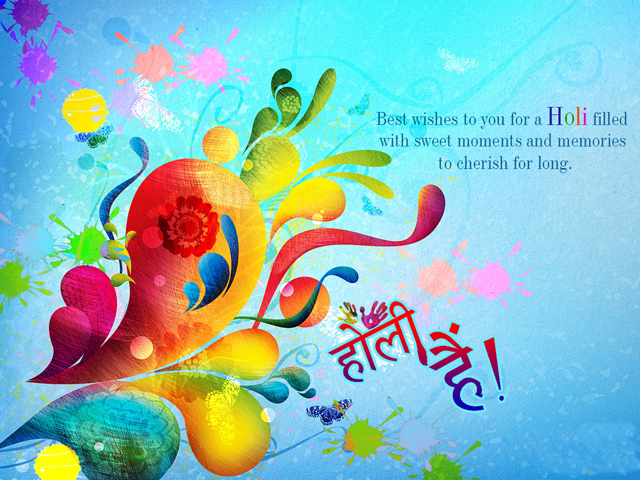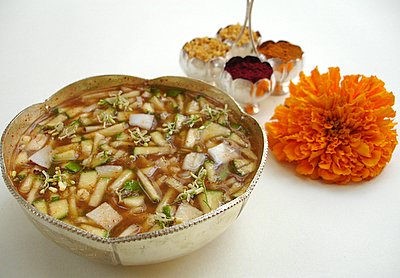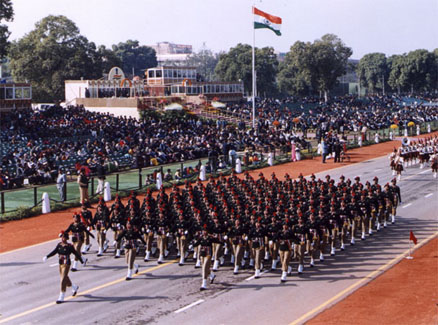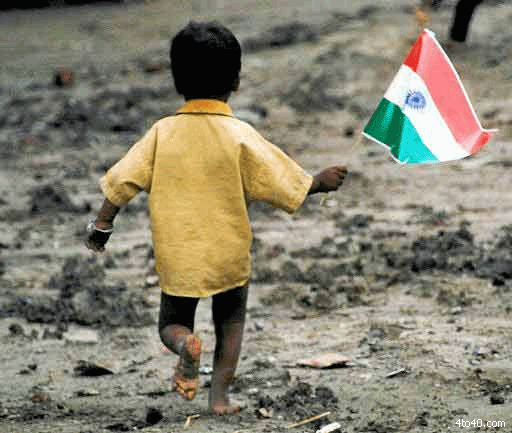Category Archives: Festivals and Events
UGADI
Ugadi is the New Year’s Day for the people of Andhra Pradesh and also for the Telugu people all over the world. Those who live north of the Vindhya hills observe it as “Barhaspatyamana”. People living to the south of the Vindhya hills observe it as “Sauramana” or “Chandramana”.
A Unique Ritual
There is a peculiarity about the practices of the various sects of Brahmins; one who is not conversant with them finds it difficult to understand their meaning. Even though they are all Brahmins certain differences in their lineage may be traced among them. These become manifest in their distinctive calendars where the dates and months vary. Some have calculations according to the solar system, and others according to the lunar system; with the result that despite all being Brahmins the New Year differs among different sects. Thus there is a Telugu New Year’s Day, a Tamil New Year’s Day, and a New Year’s distinct from these in the almanac of North India.
According to Chandramana, Ugadi is celebrated on the bright fortnight (‘Shukla Paksha’) of the first month (‘Chaitra Masa’) in the first season of the year i.e. Spring (‘Vasanta-Ritu’). As all these important elements are present, this day has special significance marking the commencement of a New Year.
Significance
It is believed that the creator of the Hindu pantheon Lord Brahma started creation on this day – “Chaitra Suddha Padhyami” or the Ugadi day. Also the calculations of the great Indian Mathematician Bhaskaracharya proclaim the Ugadi day as the beginning of the New Year, New month and New day. The onset of spring also marks a beginning of new life with plants acquiring new life, shoots and leaves. The vibrancy of life and verdant fields, meadows full of colourful blossoms signify growth, prosperity and well-being. With the coming of Ugadi, the naturally perfumed Jasmine’s spread a sweet fragrance, which is perhaps unmatched by any other in nature’s own creation. While large garlands of Jasmine are offered to Gods in homes and temples, Jasmine flowers woven in clusters adorn the braids of women.
Predictions Of The Year
Ugadi marks the beginning of a new Hindu lunar calendar with a change in the moon’s orbit. On this day, people chant mantras and the pundits make predictions for the coming year. Traditionally, the “Panchangasravanam” or listening to the yearly calendar was done at the temples or at the Town square but with the onset of modern technology, one can get to hear the priest-scholar on television sets right in one’s living room.
Preparing For The Occasion
Preparations for the festival begin a week ahead. Houses are given a thorough wash. Shopping for new clothes and buying other items that go with the requirements of the festival are done with a lot of excitement. Ugadi is celebrated with festive fervour in the states of Maharashtra, Karnataka and Andhra Pradesh. While it is called Ugadi in Andhara and Karnataka, in Maharashtra it is known as “Gudipadava”.On Ugadi day, people wake up before the break of dawn and take a head bath after, which they decorate, the entrance of their houses with fresh mango leaves. The green mango leaves tied to the doorway signify a good crop and general well being. It is noteworthy that one uses mango leaves and coconuts (as in a ‘Kalasam’, to initiate any puja) only on auspicious occasions to propitiate gods.People also splash fresh cow dung water on the ground in front of their house and draw colourful floral designs. This is a common sight in every household. People perform the ritualistic worship to God invoking his blessings before they start off with the New Year. They pray for their health, wealth and prosperity and success in business too. Ugadi is also the most auspicious time to start new ventures.
Special Delicacies
It is a season for raw mangoes spreading its aroma in the air and the fully blossomed Neem tree that makes the air healthy. Also, jaggery made with fresh crop of sugarcane adds a renewed flavour to the typical dishes associated with Ugadi.”Ugadi Pachchadi” is one such dish that has become synonymous with Ugadi. It is made of new jaggery, raw mango pieces, Neem flowers and new tamarind. The inner significance of this preparation is to indicate that life is a mixture of good and bad, joy and sorrow and all of them have to be treated alike. All experiences have to be treated with equanimity. Every one should make a resolve that he will face calmly whatever happens in this year, accepting it with good grace and welcoming everything. Consider everything as for one’s own good. Men should rise above sorrow and happiness, success and failure. This is the primary message of the Ugadi festival.In Andhra Pradesh, eatables such as “Pulihora”, “Bobbatlu” and preparations made with raw mango go well with the occasion. In Karnataka too, similar preparations are made but called “Puliogure” and “Holige”. The Maharashtrians make “Puran Poli” or sweet ‘Rotis’.
Kavi Sammelanam
Kavi Sammelanam or poetry recitation is a typical Telugu Ugadi feature. Ugadi is also a time when people look forward to a literary feast in the form of Kavi Sammelanam. Many poets come up with new poems written on subjects ranging from Ugadi to politics to modern trends and lifestyles.
Ugadi Kavi Sammelanam is also a launch pad for new and budding poets. It is generally carried live on All India Radio, Hyderabad and the Doordarshan – Hyderabad, following “Panchangasravanam” (New year calendar) narrating the way the New Year would shape up in the lives of people and the state in general. ‘Kavis’ or poets of many hues – political, comic, satirical reformist, literary and melancholic make an appearance on the Ugadi stage.Ugadi is thus a festival of many shades. It ushers in the New Year, brings a rich bounce of flora and fills the hearts of people with joy and contentment.
Happy Holi


May every day of the new year glow with good cheer & happiness for you and your family.
నేస్తాలందరికి నూతన సంవత్సర శుభాకాంక్షలు 2012.ఈ ఏడాది నాకు ఎంతో అపురూపం.ఎంతోమంది ఆత్మీయులని ఇచ్చింది. అందుకే ఈ ఏడాదికి కృతఙ్ఞతలు చెప్తూ..నూతన సంవత్సరానికి స్వాగతం పలుకుతున్నాను.
आप सभी के लिए नव वर्ष 2012 सफल एव मंगलमय हो! 🙂
Holi
Holi is the festival of color and joy. It is the day when the bright colors of Holi diminish all the discriminations of caste and creed in society. The colors of Holi also bring along with themselves the spirit of joy, naughtiness, passion and enthusiasm. The festival in itself is the celebrations of the divine love of Radha and Krishna as well as the commemoration of the fact that ‘Goodness always triumphs over evil’ and the verity that ‘Truth is always universal’. There is an eternal meaning of Holi beyond the ‘color play’ and ‘grand feasts’.
Republic day
The Republic Day of India commemorates the date on which the Constitution of India came into force replacing the Government of India Act 1935 as the governing document of India on 26 January 1950.The date 26 January was chosen to honour the memory of the declaration of independence of 1930. It is one of the threenational holidays in India, and while the main parade, Republic Day Parade takes place at the Rajpath, in the national capital New Delhi, where the president views the parade, state capitals also have their state celebrations.
Although India obtained its independence on 15 August 1947, it did not yet have a permanent constitution; instead, its laws were based on the modified colonialGovernment of India Act 1935, and the country was a Dominion, with George VI as head of state and Earl Mountbatten as Governor General. On 28 August 1947, the Drafting Committee was appointed to draft a permanent constitution, with Bhimrao Ramji Ambedkar as chairman. While India’s Independence Day celebrates its freedom from British Rule, the Republic Day celebrates the coming into force of its constitution.
A draft constitution was prepared by the committee and submitted to the Assembly on 4 November 1947. The Assembly met, in sessions open to public, for 166 days, spread over a period of 2 years, 11 months and 18 days before adopting the Constitution. After many deliberations and some modifications, the 308 members of the Assembly signed two hand-written copies of the document (one each in Hindi and English) on 24 January 1950. Two days later, the Constitution of India became the law of all the Indian lands. The Constitution of India was passed on 26 November 1949, 10.18 AM IST, but it came into effect completely only on 26th January, 1950. Following elections on 21 January 1950, Rajendra Prasad was elected as the president of India. The Indian National Congress and other parties had been celebrating 26 January as a symbol of Independence, even before India actually became independent. Thus, applying the constitution on 26 January, to mark and respect 26 January and the freedom struggle and the freedom fighters.
The amending mechanism was lauded even at the time of introduction by Ambedkar in the following words: “We can therefore safely say that the Indian federation will not suffer from the faults of rigidity or legalism. Its distinguished feature is that it is a flexible federation.
“The three mechanisms of the system derived by the Assembly, contrary to the predictions, have made the constitution flexible at the same time protected the rights of the states. They have worked better than the amending process in any other country where Federalism and the British Parliamentary system jointly formed the basis of the constitution”.
What Sir Anthony Eden, the Prime Minister of the United Kingdom (April 1955 to January 1957), said at the time of the emergence of Indian Republic is relevant in this context. He said, ‘Of all the experiments in government, which have been attempted since the beginning of time, I believe that the Indian venture into parliamentary government is the most exciting. A vast subcontinent is attempting to apply to its tens and thousands of millions a system of free democracy… It is a brave thing to try to do so. The Indian venture is not a pale imitation of our practice at home, but a magnified and multiplied reproduction on a scale we have never dreamt of. If it succeeds, its influence on Asia is incalculable for good. Whatever the outcome we must honour those who attempt it.
Even more meaningful was the opinion expressed by an American Constitutional authority, Granville Austin, who wrote that what the Indian Constituent Assembly began was “perhaps the greatest political venture since that originated in Philadelphia in 1787.”
Austin has also described the Indian Constitution as ‘first and foremost a social document.’ … “The majority of India’s constitutional provisions are either directly arrived at furthering the aim of social revolution or attempt to foster this revolution by establishing conditions necessary for its achievement.”
shivaji.. 🙂
Diwali
Diwali (also spelled Divali in other countries) or Deepavali is popularly known as the festival of lights.
The name Diwali is itself a contraction of the word Deepavali (Sanskrit: दीपावली Dīpāvali), which translates into row of lamps.Diwali involves the lighting of small clay lamps (diyas) (or Deep in Sanskrit: दीप) filled with oil to signify the triumph of good over evil. During Diwali celebrants wear new clothes and share sweets and snacks with family members and friends. Some Indian business communities begin the financial year on the first day of Diwali, hoping for prosperity the following year.
![Shubh_Deepavali_Wishes-Diwali-161_b[1]](https://shivajivarma.files.wordpress.com/2010/11/shubh_deepavali_wishes-diwali-161_b1.gif?w=300&h=225)
In Hinduism, Deepavali marks the return of Lord Rama to his kingdom of Ayodhya after defeating (the demon king) Ravana, the ruler of Lanka, in the epic Ramayana. In Jainism, Diwali marks the attainment of moksha by Mahavira in 527 BC. In Sikhism, Deepavali commemorates the return of Guru Har Gobind Ji to Amritsar after freeing 52 Hindu kings imprisoned in Fort Gwalior by Emperor Jahangir; the people lit candles and diyas to celebrate his return. This is the reason Sikhs also refer to Deepavali as Bandi Chhorh Divas, “the day of release of detainees”. Deepavali is considered a national festival in India and Nepal.
Diwali festival is a 5 day Hindu festival in India which occurs on the fifteenth day of Kartika. Diwali when translated means “rows of lighted lamps” and the occasion is also referred to as the Festival of Lights.
During Diwali, Indian homes are cleaned and windows are opened to welcome Lakshmi, the goddess of wealth. Lamps, lights and candles are lit as a greeting to Goddess Laksmi.
Gifts are exchanged and sweets, festive meals are prepared during Diwali. Because there are many castes and regions in India, there are myriad manifestations of the Diwali festival.
- In some places, the festival begins with Dhanteras, a day set aside to worship Laksmi. In the Indian culture, wealth is not viewed as a corruptive power. Instead, a wealthy person is considered to have been rewarded for good deeds of a past life, i.e karma.
- On the second day of the festival, Kali, the goddess of Strength, is worshipped.
- On the 3rd day ( the last day of the year in the lunar calendar), lamps are lighted and shine brightly in homes. The lamp symbolizes knowledge.
- The fourth day of Diwali falls on the first day of the lunar New Year. At this time, old business accounts are settled and new books are opened. The books are worshipped in a special ceremony by Indian priests and participants are encouraged to remove anger, hate, and jealousy from their lives.
- On the last day (Balipratipada) of the festival, Bali, an ancient Indian king, is recalled and remembered. Bali destroyed the centuries old philosophies of the society. However, in addition to this, he is remembered for being a generous and kind person. Hence, the significance of this day is to see the good in others, including enemies.
The Jain communities of India celebrate Diwali as a New Year’s Day. Lord Mahavira, the founder of Jainism, attained his Nirvana on the day of Diwali. Sikhs celebrate Diwali to express joy at the return of the sixth Guru to Amritsar in 1620; Emperor Jahangir had imprisoned him along with 52 Hindu kings.
The Guru was granted freedom but refused to leave until the kings were also released.
Diwali is by far the most enthusiastically enjoyed festival in India. People of different nationalities, races, religions and backgrounds come together to share their joys generating a feeling of universal brotherhood and inter-religious harmony.
Friendship Day
 FRIENDSHIP is a network that needs: no recharge! no charging! no validity! no activation! just don’t switch off your HEART ! Signal is EVERYWHERE and its all for free!! Friendship Day celebrations actually began in US in 1935. The United States Congress, proclaimed the first Sunday of August as National Friendship Day. Gradually the festival gained popularity and today Friendship Day is celebrated in a large number of countries. India is one among them. On this day friends greet each other with exchange of gifts and cards and makes this day very special in their own style..
FRIENDSHIP is a network that needs: no recharge! no charging! no validity! no activation! just don’t switch off your HEART ! Signal is EVERYWHERE and its all for free!! Friendship Day celebrations actually began in US in 1935. The United States Congress, proclaimed the first Sunday of August as National Friendship Day. Gradually the festival gained popularity and today Friendship Day is celebrated in a large number of countries. India is one among them. On this day friends greet each other with exchange of gifts and cards and makes this day very special in their own style..
shivaji…………. 😛




![ramayana_divineloophole_cover-thumb-250x229-14254[1]](https://shivajivarma.files.wordpress.com/2010/11/ramayana_divineloophole_cover-thumb-250x229-142541.jpg?w=594)